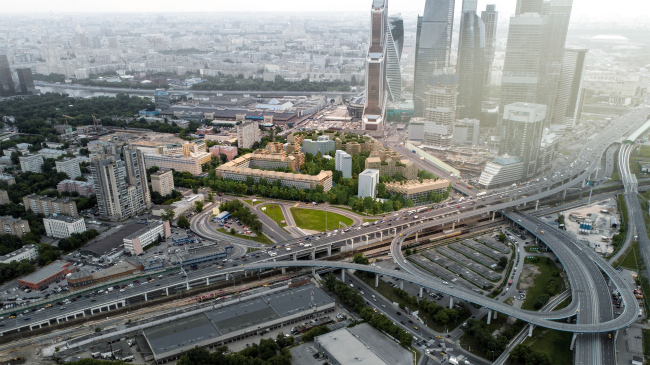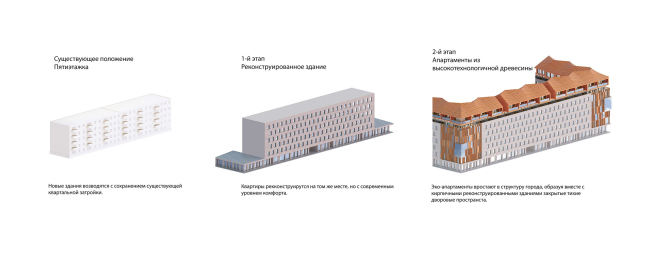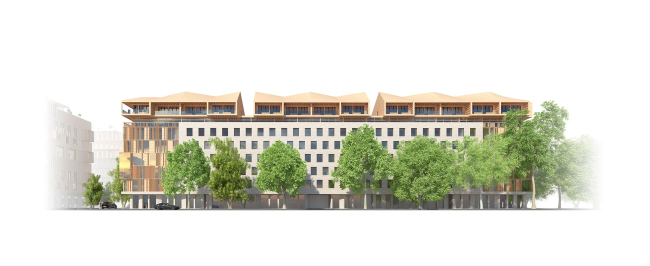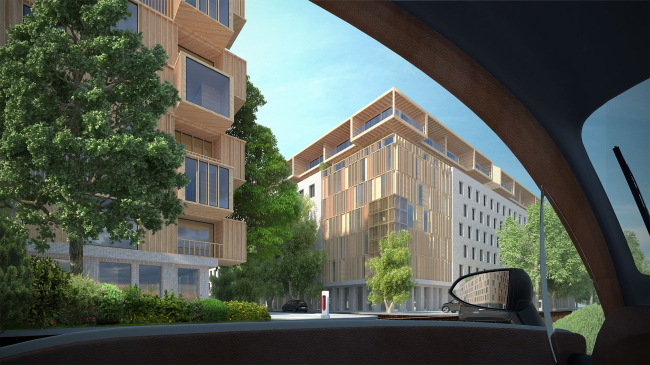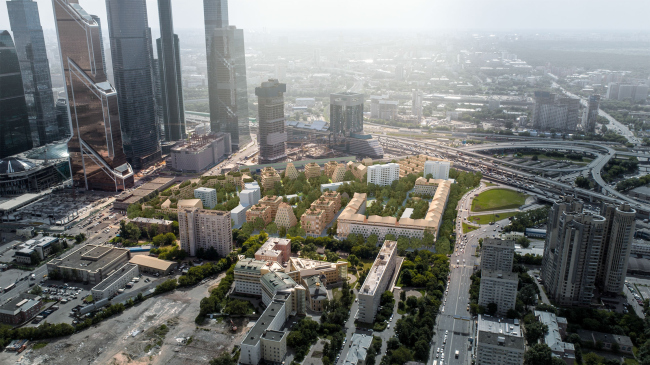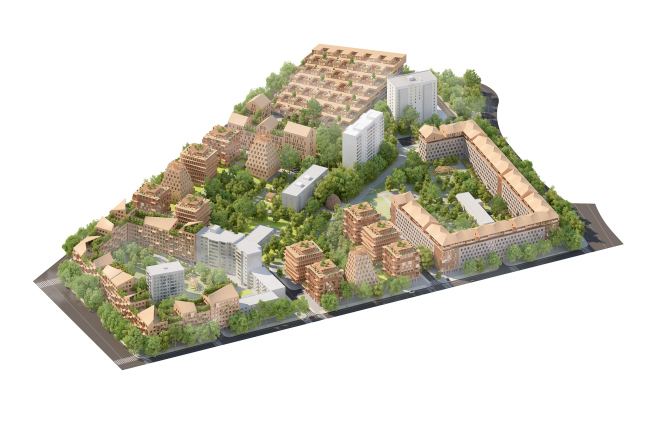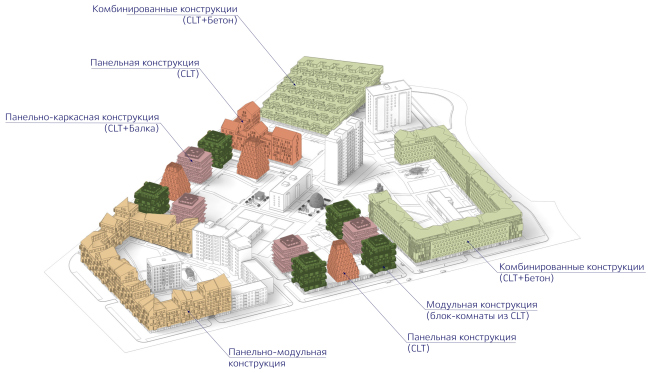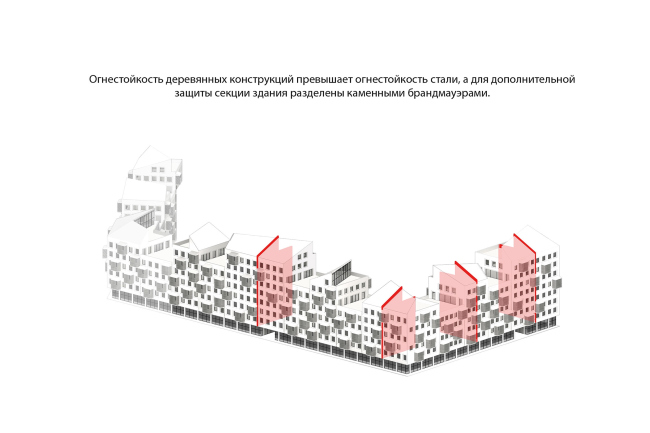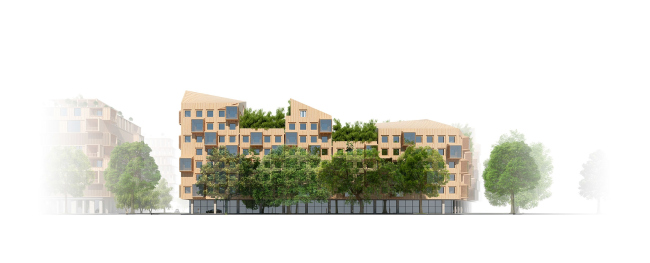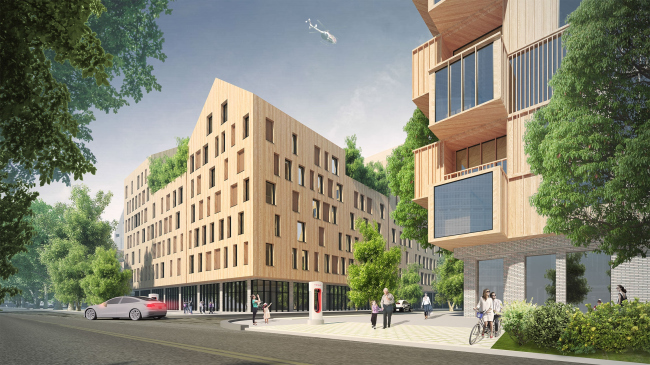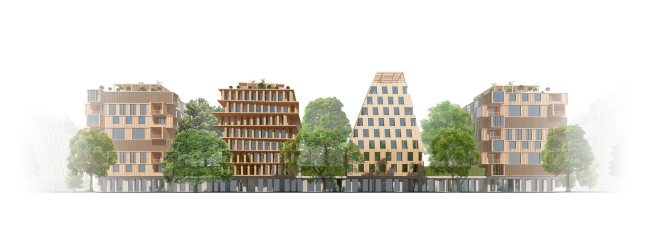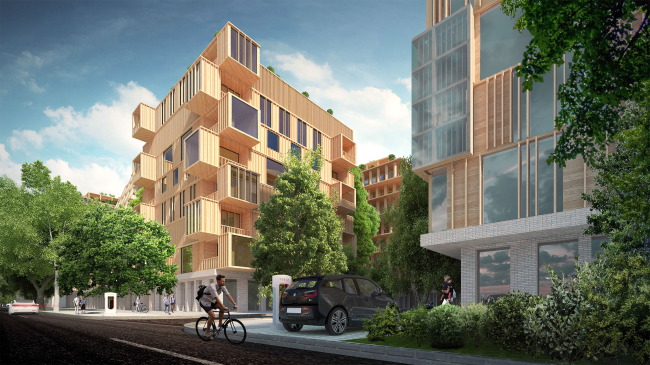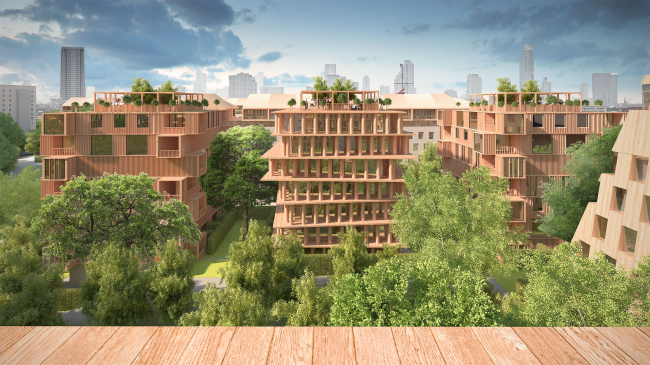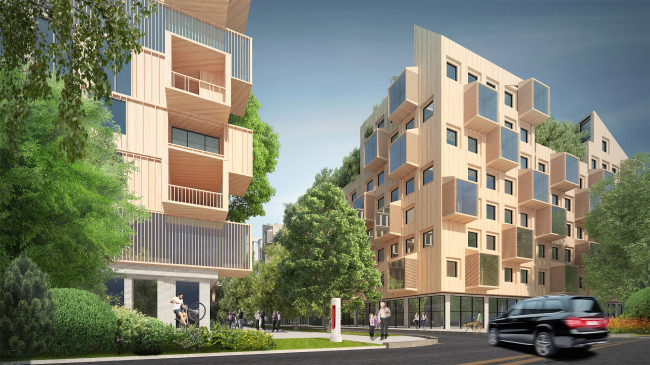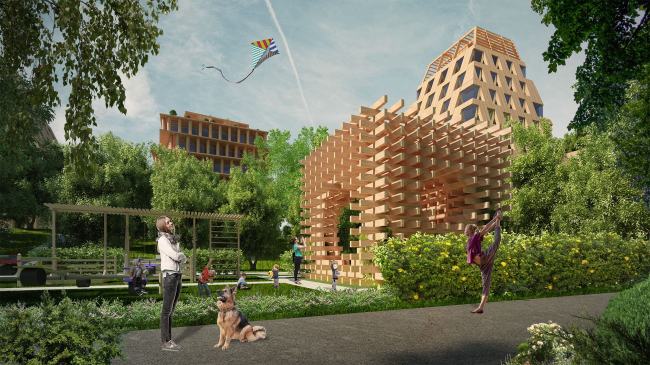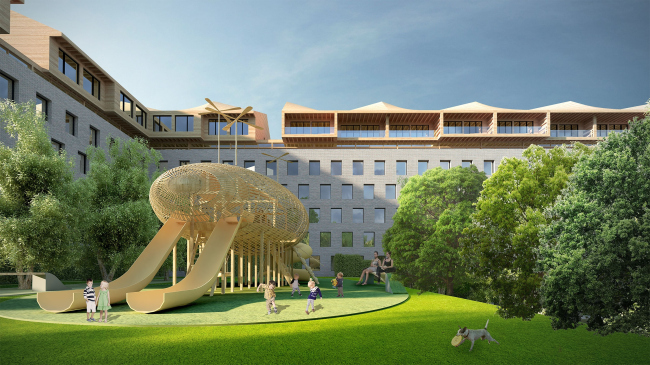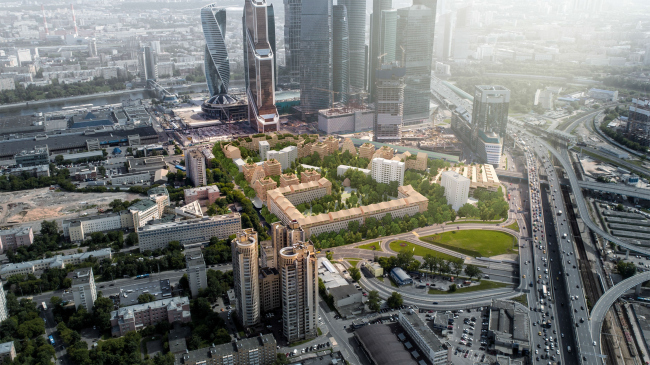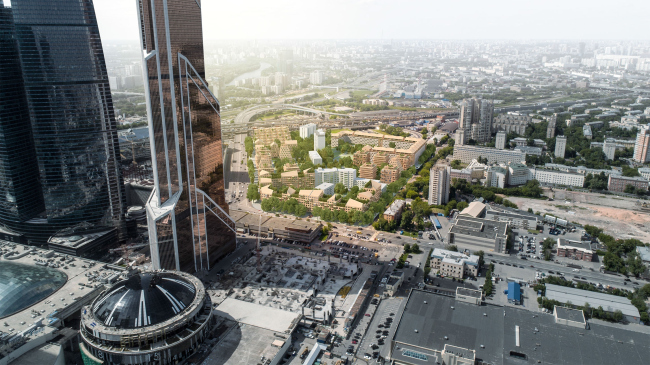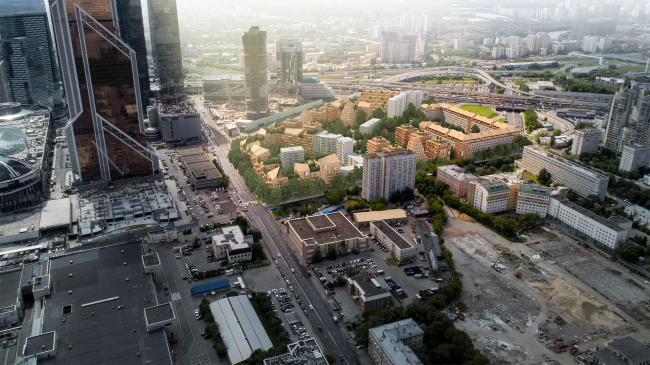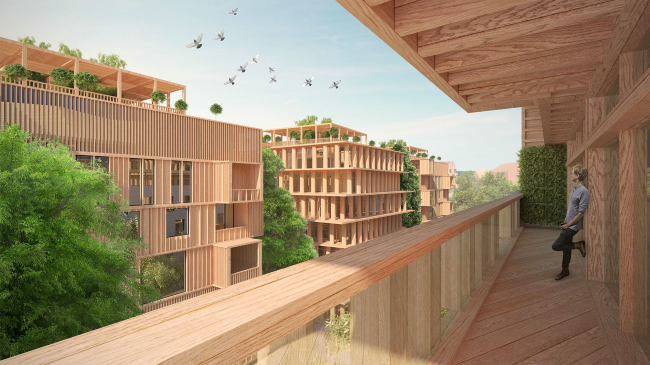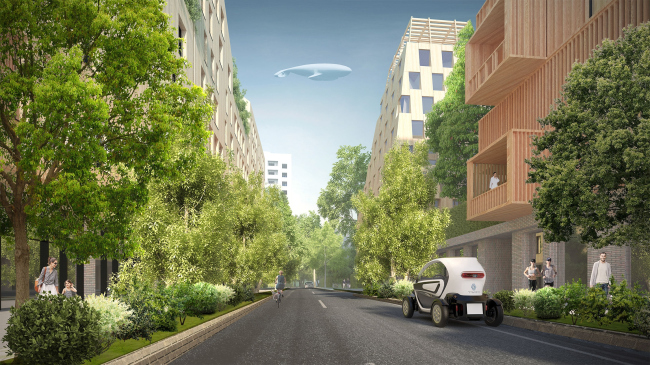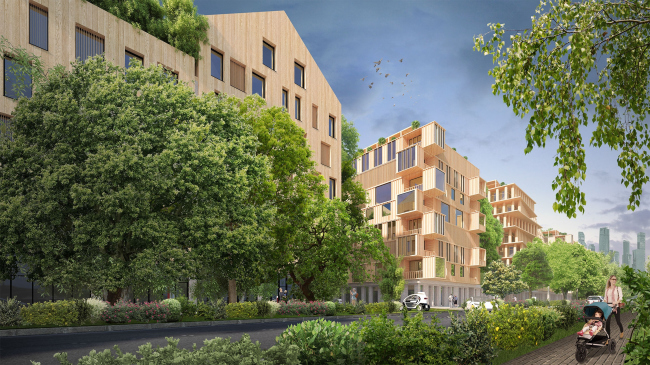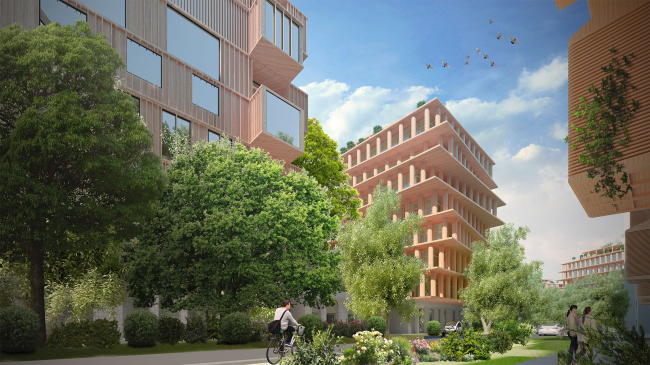|
Published on Archi.ru (https://archi.ru) |
|
| 26.04.2018 | |
|
Wooden Stones |
|
|
|
|
| Studio: | |
| Totan | |
|
The conceptual project by Totan Kuzembaev and the Sokolsky woodworking integrated plant is meant to demonstrate the diversity of design solutions that use wooden CLT panels, and the possibilities for combining these panels with concrete structures, including the field of renovating the Soviet-era five-story houses instead of tearing them down completely. Wood City housing complex © Totan Kuzembaev Architectural StudioThe concept of a multistory wooden cluster named “Wood City” was developed by Totan Kuzembaev Architectural Studio at the request of the Sokolsky woodworking integrated plant, part of Segezha Group. The project is of the “paper” kind to some extent, its purpose being to demonstrate, at the example of a specific platform, the potential of wooden multistory housing construction with the use of the CLT (cross laminated timber) panels. It is not accidental that the name of this visionary project echoes that of the famous Finnish project “Wood Town”, which was developed in 1997 by the University of Oulu; it was about popularizing wooden construction in Finland, and the project was a success: today, Finland builds multistory residential houses with a large share of wooden structures used in their construction. In Russia, however, the idea of multistory wooden construction is still waiting for the amendments to the existing construction rules and regulations, as well as for steady production of the building materials. As a demonstration platform, the architects chose a Moscow micro-district named “Kamushki” (which literally translates as “Little Stones”), lying north of the Moscow City business center. In 2006, the Creative Union “Reserve” designed a housing and business complex here; today, the brick five-stories got into the housing renovation program – in their stead, Totan Kuzembaev designed houses of his own, and for some buildings on the corner he even proposed a possibility of reconstruction (without being torn down) by building new independent structures – wooden casings for the old buildings – and improving the living conditions by expanding the floor space and adding a mansard floor. This in fact was the development of the idea that was widely discussed in 2017 immediately after the renovation program was announced: why tear things down if we can reconstruct them? It is clear that not everyone is chuffed at the prospect of getting his beloved home torn down. The opportunities for reconstruction combined with widening of the floor space are demonstrated in houses #20, 18, 3 and 5 in the southern part of the territory, between the 1st and 2nd Krasnogvardeiskiy drives and the Antonova-Ovseenko Street: a few five-story houses, which form here the perimeter of a large yard, are turned by Totan Kuzembaev into a city block united by a concrete public first floor. At first, the five-story houses are reconstructed, and after that they get a buildup of wooden mansards or penthouses; the spaces between the buildings are filled with wooden structures which close the perimeter and take this city block to the scale of “Stalin-construction” houses. Wood City housing complex © Totan Kuzembaev Architectural StudioWood City housing complex © Totan Kuzembaev Architectural StudioWood City housing complex © Totan Kuzembaev Architectural StudioWood City housing complex © Totan Kuzembaev Architectural StudioIn his project, Totan Kuzembaev deliberately proposes different types of structures and layouts. In the north corner, in the area where houses #33, 31 and 11 are situated, there is a concrete parking lot with an apartment building, which in terraced steps “cascades” down its roof – pretty much the way BIG did it in the Guide to the Ørestad district of Copenhagen, only in this instance the originality of Totan Kuzembaev’s idea consists in a combined construction plan of wood and concrete. Wood City housing complex © Totan Kuzembaev Architectural StudioNevertheless, it is not only the parking lot that is made of concrete. All the houses here rest upon the podiums of concrete ground floors that contain public functions: cafés, shops, children’s clubs and everything that is naturally expected from the modern urban environment. The houses that are made fully from wood, barring the first concrete floor, are subdivided into several types in accordance with their construction: panel type – made from CLT panels, modular – made from prefabricated modules, panel/modular and panel/framework ones – the latter combine panels and beams of glued wood. The diagram of construction solutions. Wood City housing complex © Totan Kuzembaev Architectural StudioAnd, if we are to speak about the layouts, the western part, which is closer to the Third Transport Ring, gets yet another city block of varying height, built with a panel/modular technology, which completes the group of renovated houses. This is a sectional house, and at the joints its sections are separated by concrete firewalls in order to make the building really fireproof. But then again, CLT panels are fireproof as it is because this is a massive structure – says the Vice President of Segezha, Dmitry Rudenko. Wood City housing complex © Totan Kuzembaev Architectural StudioThe western block, unlike the southern one, is of ostentatiously varying height: it sports romantic pitched roofs, separated by green terraces on the level of the fifth floor. Glittering from behind the tree trunks, the glass of the window panes on the bottom floors creates an effect of a “hanseatic town” hovering in a cloud of greenery. Wood City housing complex © Totan Kuzembaev Architectural StudioWood City housing complex © Totan Kuzembaev Architectural StudioWood City housing complex © Totan Kuzembaev Architectural StudioHowever, neither the austere and dense block that is reconstructed from the surviving five-story buildings, nor the light winsome little city with pitched roofs come close to the towers that the architect placed in the middle: three Aztec pyramids with a cutoff top are (panel) and four panel/framework houses with “dancing” floors (the framework is needed to support the dance) and panoramic windows on all of the floors. And five modular houses, in which many of the volumes stand out like building blocks in a toy construction set, making a parade of the possibilities of the wooden cantilevered structures, which are definitely richer than those of concrete. These buildings look like avant-garde structures, whose purpose is to surprise people with their diversity. However, in addition to the spectacular plastic solutions – and we are stressing it here – each of them is tied to a specific type of construction elements set, demonstrating its advantages and potential. Wood City housing complex © Totan Kuzembaev Architectural StudioWood City housing complex © Totan Kuzembaev Architectural StudioWood City housing complex © Totan Kuzembaev Architectural StudioWood City housing complex © Totan Kuzembaev Architectural StudioThe play of the volumes is further supported by the children’s playgrounds/art objects in the yards. Wood City housing complex © Totan Kuzembaev Architectural StudioWood City housing complex © Totan Kuzembaev Architectural Studio*** “It was the architects’ initiative to propose several types of houses, and now we can see the new housing units, built in the spaces between the already existing buildings, organically turn this micro-district, built back in the 1960’s, into a modern city block. There was no question about who should become the author of this project. Totan Kuzembaev is a true virtuoso in the field of wooden construction, he understands it and he feels it like nobody else does – Dmitry Rudenko says – In this country, there has been a lot of talk about wooden housing construction but this notion most of the time comes down to a single cottage built with the use of traditional technology from logs, or, at best, from glued timber, while wooden structures have been long since been used in the housing construction all over the globe, just as in the construction of public and office buildings. In order to showcase the real potential, we decided to take a venue in Moscow and use it as an example of a city block, in which modified wood is extensively used, specifically, CLT as the most promising material, whose operational properties are as good as those of concrete. We want to show that it’s about modern architecture, and not about village huts. The Wood City project is a part of the global strategy because just coming up with the idea of a city block does not yet mean building it. It is necessary not only to change the construction rules and regulations with regard to the new materials but, in the light of the prospects for such changes, launch the production of such materials by building new integrated house construction factories that would make houses from wood instead of concrete”. Wood City housing complex © Totan Kuzembaev Architectural StudioWood City housing complex © Totan Kuzembaev Architectural StudioWood City housing complex © Totan Kuzembaev Architectural StudioWood City housing complex © Totan Kuzembaev Architectural Studio“So far, we are only dreaming of wooden high-rises, and in many countries they are a reality. For our company, which has been working in the field of wooden architecture for a long time, this project became an opportunity to work with “quite different wood”. The new wood-based materials, just environmentally friendly as wood itself, and the appearance of a modern wooden city block are just as important as the appearance of a new park in the city” – Totan Kuzembaev says. Wood City housing complex © Totan Kuzembaev Architectural StudioOh, and by the way, about ecology! Wood as such is an environmentally friendly and sustainable material. In addition, the modular structures are capable of making the very construction process more ecological: due to the fact that they are only assembled together on the construction site, there will be neither dust nor dirt around. About the abundance of greenery that the project provides for: it is there in the yards, on the new roofs and even on the balconies, in accordance with the Singapore principle “place green plants wherever possible”. This must enhance the environmental message of the project: according to estimates, within twenty four hours the Earth grows enough trees to provide building materials for the construction of a wooden city block eight stories high. This green wooden block looks against the contrastive background of the Moscow City business center as a welcome oasis. According to the project, trees are also planted along the perimeter of the block, creating a “green screen” between the houses and the busy city highways. Wood City housing complex © Totan Kuzembaev Architectural StudioWood City housing complex © Totan Kuzembaev Architectural StudioWood City housing complex © Totan Kuzembaev Architectural StudioTherefore, Wood City became an alternative, though slightly utopian, to the traditional Moscow approach to renovation. The height here only reaches 9 floors. *** “We have material classification standards for metal, brick, concrete, and even glass – says the coauthor of the project Olzhas Kuzembaev – However, so far, there are no such classification standards for wood, it is only being developed now. When the construction rules include the classification for wooden structures and materials, this will hail the beginning of the new era of industrial-scale wooden construction. All of the technologies that we proposed are basically ready to be used on an industrial construction scale. Which, in addition to the obvious economic benefits, contains a positive social aspect as well: it decreases the need for unskilled labor. Besides, this country currently exports more than 90% of industrial wood; abroad, it already considered as a high-technology material. And this in inefficient from the macroeconomic standpoint. In this project, our mission was to show that the industry of wooden housing construction can be just as up-to-date as the construction of any other materials, and in some aspects, even surpass them”. Indeed, it does not look probable that Wood City can be implemented any time soon but the future is being brought closer to us by the issued in the late March of 2018 second edition of set of rules for the multi-apartment and public buildings with the use of wooden structures (rules for design and construction), which already cover the new wood-based materials. Still, the question remains open about certifying the modified wood-based materials, which are widely used in construction in many countries, such as CLT (that Wood City is built from), LVL and MXM. While all of these Issues are being settled, the wooden high-rises could be built on project specific technical conditions – in any case, our architects are ready for this. |
|
